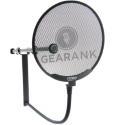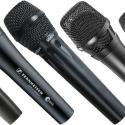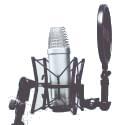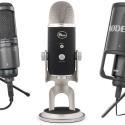What Does a Pop Filter Do On a Mic? Why You Must Have One
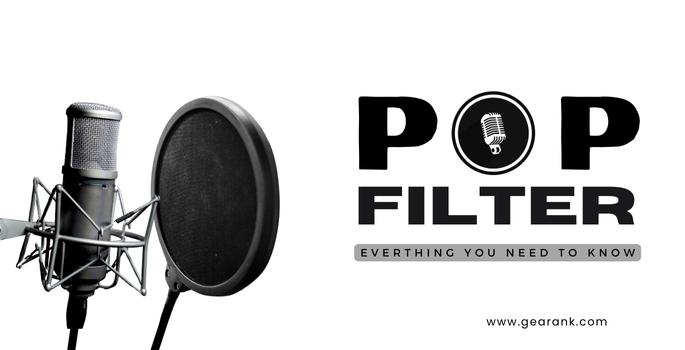
As an experienced singer or voice-over artist, you may have encountered issues when emphasizing certain words that cause the microphone signal to clip. These unwanted noises can significantly impact the quality of your recording, even if the overall performance is excellent.
To address this problem, pop filters serve as a crucial safety net during the recording process by blocking plosive sounds that may result from speech or singing. With the help of these filters, you can focus on delivering your best performance in the recording booth without worrying about extra noises that may interfere with your output.
But how does it work, and what does a pop filter do to block plosive sounds? Read on to find out.
What Is A Pop Filter?
A pop filter, also known as a pop shield, is a microphone accessory that is used to minimize or eliminate "plosive" sounds caused by consonants such as "p" or "b," as well as other unwanted mouth noises. It is placed between the microphone capsule and the voice to achieve this.
Typically, a pop filter comprises a circular metal or plastic disc with a semi-transparent mesh or metal screen sandwiched in the center. An adjustable gooseneck with a clamp is attached to the end of the mic stand to hold the pop filter in place. This arrangement helps to reduce or eliminate plosive sounds and other unwanted mouth noises that may occur in different directions.
Why do plosive sounds occur?
When speaking into a microphone, the proximity of the speaker's mouth to the mic can produce plosive sounds. These sounds are characterized by harsh sound quality and occur when pronouncing consonants such as p, b, s, and t. Such consonants contain high-frequency content, and the popping sounds occur in parts of the speech that receive more emphasis.
Plosive sounds can cause clipping audio during recording due to high air pressure. This can occur even with the best condenser mic, as fast-moving air can overwhelm the microphone's sensitivity, even at conservative gain levels. Some microphones, like broadcast dynamic microphones, have built-in pop filters. An integral pop filter built into a mic can help better mitigate unwanted popping sound recorded in home studio setups. Note that a pop filter differs from a built-in mic windscreen, so you should still have a pop filter handy.
What Does A Pop Filter Do?
A pop filter serves as an effective solution to prevent the popping sound of air that passes through the microphone. How does a pop filter work? The mesh filter of the pop filter disperses and softens the mechanical impact of air, resulting in a cleaner sound output without any popping noises. Besides this, a pop filter can also be helpful for recording vocals or voice acting without clipping the signal with plosive sounds. This is particularly helpful in maintaining the recording at optimal levels.
Aside from dealing with unwanted background noise related to plosives, a pop filter also keeps moisture or saliva from hitting the mic, which could gradually degrade the microphone over time. During vocal recordings, certain consonants may generate moisture and saliva that reaches the mic diaphragm, leading to buildup. A pop filter can effectively prevent this, ensuring a clear and consistent sound output.
Setting up a pop filter
When attaching a typical pop filter to a microphone stand, it is important to ensure that the filter clamp is securely fastened to the tip of the mic stand arm. The mesh filter's gooseneck should be bent at the microphone's diaphragm for optimal positioning.
Maintaining a distance of at least 4-6 inches between the pop filter and the microphone is crucial to prevent plosives.
Singers can perform directly into the pop screen or maintain a 2-inch distance from it. Following this setup will ensure that your pop screen will effectively eliminate popping sounds caused by plosives.
It is best to place your mic in a treated room. Consider making a DIY vocal booth for better captures.
What is The Best Material For A Pop Filter?
Pop filters are available in various sizes and materials. For situations that involve significant movement, it is advisable to opt for a studio pop filter with a larger diameter to prevent excessive air from passing through.
When it comes to the filter's material, you can choose between a nylon mesh or a metal filter. Regardless of the material you prefer, you can easily find a professional pop filter at any local music store for a reasonable price.
Nylon Mesh Filer
Nylon mesh pop filters are popular among recording engineers for reducing sound during vocal recordings. These filters work by absorbing and dispersing the air, producing a cleaner sound with reduced harsh high frequencies.
However, nylon pop filters can be challenging to clean due to the accumulation of moisture or saliva over time. It is crucial to disinfect them regularly to maintain their effectiveness. Applying too much pressure on the mesh can also cause damage and snags, making it necessary to handle them with care.
Metal Filter
Metal mesh is a commonly used material for pop filters in audio recording to reduce plosive sounds. Unlike a nylon mesh pop filter, a fine mesh metal screen deflects the air without any deformation. Metal pop filters are known for their superior durability compared to nylon ones.
However, they are prone to getting corroded due to moisture and saliva and can be easily bent.
What If I Don't Have A Microphone Pop Filter?
If need a pop filter but you don't have one yet, there are some alternatives you can consider to enhance the quality of your audio recordings. You can place your microphone a few inches away from the sound source to minimize noise and plosives.
Additionally, standing slightly off-axis can help reduce undesired noise by lowering the airflow.
However, it's important to note that standing a little off-axis will decrease your ability to benefit from the proximity effect, which is the bass boost you receive from being close to the mic.
Most pop filters have a wire mesh that can filter out loud blasts and air blasts from speech, allowing you to benefit from the proximity effect.
An alternative method it to make your own pop filter, which involves using a circular frame or wire coat hanger and stretching woven nylon. This improvised pop shield (DIY pop filter) can reduce unwanted popping sounds due to plosives when recording in a home studio.
Final Thoughts
So, what does a pop filter do with plosives? A good pop filter is meant for eliminating popping sounds cause by certain consonants, such as "P," "B," and "T," are pronounced.
Pop filters are an effective acoustic solution that can be seamlessly integrated into any recording or broadcasting setup by positioning them in front of the microphone.
Moreover, pop filters can significantly improve vocal clarity by filtering out unwanted noise and reducing sibilance, resulting in more consistent and professional sound quality. These acoustic filters are user-friendly and relatively affordable, making them an indispensable tool for any recording studio or podcasting space.
Contributors:
- Allen Articulo - Co-writer
- Jerry Borillo - Illustrator




